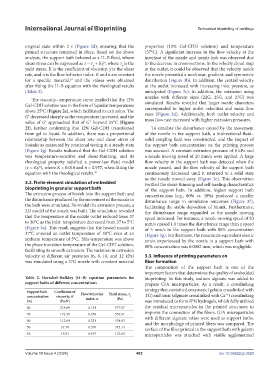Page 490 - IJB-10-4
P. 490
International Journal of Bioprinting Embedded bioprinting of cartilage
original state within 2 s (Figure 2d), ensuring that the properties (12% Gel-CDH solution) and temperature
printed structure remained in place. Based on the above (37°C). A significant increase in the flow velocity at the
analysis, the support bath behaved as a H–B fluid, whose interface of the nozzle and nozzle hub was observed due
. n
shear stress can be expressed as τ = τ + Kγ , where τ is the to the decrease in cross-sections. In the velocity cloud map
y
y
.
yield stress, K is the coefficient of viscosity, γ is the shear at the outlet, it could be observed that the velocity inside
rate, and n is the flow behavior index. K and n are constant the nozzle presented a nonlinear, gradient, and symmetric
for a specific material, and the values were obtained distribution (Figure 3b). In addition, the central velocity
29
after fitting the H–B equation with the rheological results at the outlet increased with increasing inlet pressure, as
(Table 2). anticipated (Figure 3c). In addition, the extrusion using
The viscosity–temperature curve implied that the 12% nozzles with different sizes (22G, 25G, and 27G) was
Gel-CDH solution was in the form of liquid at temperatures simulated. Results revealed that larger nozzle diameters
above 25°C (Figure 2e), which facilitated its extrusion. The corresponded to higher outlet velocities and mass flow
Gʹ decreased sharply as the temperature increased, and the rates (Figure 3d). Additionally, both outlet velocity and
value of Gʹ approached that of G˝ beyond 25°C (Figure mass flow rate increased with higher extrusion pressures.
2f), further confirming that 12% Gel-CDH transitioned To simulate the disturbance caused by the movement
from gel to liquid. In addition, there was a proportional of the nozzle in the support bath, a bidirectional fluid–
relationship between the shear rate and shear stress of solid coupling field was constructed, and the impact of
bioinks as measured by rotational testing at a steady state the support bath concentration on the printing process
(Figure 2g). Results indicated that the Gel-CDH solution was assessed. A constant extrusion pressure of 8 kPa and
was temperature-sensitive and shear-thinning, and its a nozzle moving speed of 20 mm/s were applied. A large
rheological property satisfied a power-law fluid model flow velocity in the support bath was detected when the
(τ = Kγ ), where K = 0.018 and n = 0.957, when fitting the nozzle passed, and the flow velocity of the support bath
. n
equation with the rheological results. 30 continuously decreased until it returned to a solid state
as the nozzle moved away (Figure 3e). This observation
3.2. Finite element simulation of embedded verified the shear-thinning and self-healing characteristics
bioprinting in granular support bath of the support bath. In addition, higher support bath
The extrusion process of bioink into the support bath and concentrations (e.g., 80% vs. 40%) produced a smaller
the disturbance produced by the movement of the nozzle in disturbance range in simulation outcomes (Figure 3f),
the bath were simulated. To model the extrusion process, a facilitating the stable deposition of bioink. Furthermore,
2D model of the nozzle was built. The simulation revealed the disturbance range expanded as the nozzle moving
that the temperature at the nozzle outlet reduced from 37 speed increased. For instance, a nozzle moving speed of 20
to 30°C as the inlet temperature decreased from 37 to 5°C mm/s caused 1.6 times the disturbance range than a speed
(Figure 3a). This result suggests that the heated nozzle at of 5 mm/s in the support bath with 80% concentration
37°C ensured an outlet temperature of 30°C even at an (Figure 3g). Furthermore, the maximum equivalent elastic
ambient temperature of 5°C. This temperature was above strain experienced by the nozzle in a support bath with
the phase transition temperature of the Gel-CDH solution, 80% concentration was 0.0002 mm, which was negligible.
facilitating its smooth extrusion. The variation in extrusion
velocity at different air pressures (6, 8, 10, and 12 kPa) 3.3. Influence of printing parameters on
was simulated using a 27G nozzle with constant material fiber formation
The composition of the support bath is one of the
important factors that determines the quality of embedded
Table 2. Herschel–Bulkley (H–B) equation parameters for bioprinting. In this study, sodium alginate was added to
support baths of different concentrations prepare G/A microparticles. As a result, a crosslinking
Support bath Coefficient of Flow behavior Yield stress, τ strategy that contained enzymatic (gelatin crosslinked with
2+
concentration viscosity, K index, n (Pa) y TG) and ionic (alginate crosslinked with Ca ) crosslinking
(%) (Pa·S ) was introduced to form IPN hydrogels, which fully utilized
n
80 218.69 0.134 577.87 the residual microparticles in the printed structures to
70 172.38 0.258 559.31 improve the connection of the fibers. G/A microparticles
60 112.64 0.331 434.63 with different alginate ratios were used as support baths,
and the morphology of printed fibers was compared. The
50 47.70 0.376 343.14 surface of the fiber printed in the support bath with gelatin
40 15.81 0.497 122.69 microparticles was attached with visible agglomerated
Volume 10 Issue 4 (2024) 482 doi: 10.36922/ijb.3520

